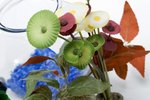The brilliantly colored Japanese fighting fish (Betta splendens), also known as the betta fish or Siamese fighting fish, is known and named for aggressive behavior. Native to Thailand, Malaysia, Indonesia, Vietnam and China, the Japanese fighting fish was bred in captivity originally for to produce specimens suitable for organized fights between males, similar to cock-fighting. Today, the Japanese fighting fish is one of the most popular fish to own after goldfish, thanks to his stunning beauty, dramatic long, flowing fins and ease of care.
Habitat
Select a tank for your Japanese fighting fish that's between 5 and 10 gallons. Japanese fighting fish originate from tropical waters, so purchase a heater and thermometer to help maintain a temperature between 70 and 80 degrees. A filter can be installed, but it should be gentle and not produce strong currents, which can make swimming difficult for your fish. For the substrate, use sand or gravel that's 2 inches deep. Even in captivity, the Japanese fighting fish instinctively knows he's prey, so provide plenty of hiding places so he can feel secure. You can include various plants, moss and smooth rocks. Avoid using jagged rocks, and plastic plants, which can tear the fish's delicate fins. To be safe, purchase silk or live plants.
Diet
In the wild, the Japanese fighting fish is a carnivore who prefers dining on insects and insect larvae. Feed him the same high protein diet of meaty food, including blood worms, Grindal worms, Daphnia, brine shrimp and other small crustaceans. He'll also adapt to eating betta pellets and freeze-dried fish food. Feed the Japanese fighting fish once or twice per day, but be careful not to overfeed, which can harm his health. Avoid feeding him no more than he can gobble down in two to five minutes.
Tank Companions
The male Japanese fighting fish is particularly territorial and will fight another in the same aquarium. However, you can keep several females together with a single male typically without any problems. Male betta fish become aggressive toward other fish that resemble them in appearance, mistaking them for betta rivals intent on taking his territory. To ensure peaceful cohabitation in the aquarium, avoid keeping male Japanese fighting fish with other species that have similar body shapes, long fins or large amount of red or blue coloring.
Maintenance
Regular water changes will help maintain a pristine environment in your aquarium. Fish waste and other debris, such as uneaten food and decomposing plants, cause ammonia buildup in the aquarium, causing the Japanese fighting fish to become more susceptible to illness. If you go too long without changing the water, it can develop a yellow tint, indicating bacteria in the water and other toxins. To avoid upsetting the fish, change small amounts of water each week rather than all the water at once. Make sure the water you're adding to the aquarium is the same temperature as the old water you're removing.
References
- Fishlore: Betta Fish - Betta Splendens
- Japanese Fighting Fish: Home to Betta Fish Care
- AquariumGuys: How to Care for Your Betta Fish
- First Tank Guide: Betta Care Basics
- All Aquarium Info: Keeping Bettas or Siamese Fighting Fish
- Aquatic Community: Feeding Betta Fish
- Japanese Fighting Fish: How to Set Up a Beautiful Betta Fish Tank





